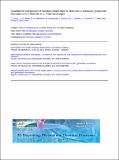Quantitative comparison of electron temperature fluctuations to nonlinear gyrokinetic simulations in C-Mod Ohmic L-mode discharges
Author(s)
Holland, C.; Howard, N. T.; Sung, Choongki; White, Anne E.; Mikkelsen, David; Theiler, Christian; Greenwald, Martin J.; Churchill, Randy; ... Show more Show less
DownloadAnne White Sung - Phys of Plasmas 23 4 2016.pdf (3.366Mb)
PUBLISHER_POLICY
Publisher Policy
Article is made available in accordance with the publisher's policy and may be subject to US copyright law. Please refer to the publisher's site for terms of use.
Terms of use
Metadata
Show full item recordAbstract
Long wavelength turbulent electron temperature fluctuations (k[subscript lower case y]ρ[subscript lower case s] < 0.3) are measured in the outer core region (r/a > 0.8) of Ohmic L-mode plasmas at Alcator C-Mod [E. S. Marmar et al., Nucl. Fusion 49, 104014 (2009)] with a correlation electron cyclotron emission diagnostic. The relative amplitude and frequency spectrum of the fluctuations are compared quantitatively with nonlinear gyrokinetic simulations using the GYRO code [J. Candy and R. E. Waltz, J. Comput. Phys. 186, 545 (2003)] in two different confinement regimes: linear Ohmic confinement (LOC) regime and saturated Ohmic confinement (SOC) regime. When comparing experiment with nonlinear simulations, it is found that local, electrostatic ion-scale simulations (k[subscript lower case y]ρ[subscript lower case s] ≲ 1.7) performed at r/a ∼ 0.85 reproduce the experimental ion heat flux levels, electron temperature fluctuation levels, and frequency spectra within experimental error bars. In contrast, the electron heat flux is robustly under-predicted and cannot be recovered by using scans of the simulation inputs within error bars or by using global simulations. If both the ion heat flux and the measured temperature fluctuations are attributed predominantly to long-wavelength turbulence, then under-prediction of electron heat flux strongly suggests that electron scale turbulence is important for transport in C-Mod Ohmic L-mode discharges. In addition, no evidence is found from linear or nonlinear simulations for a clear transition from trapped electron mode to ion temperature gradient turbulence across the LOC/SOC transition, and also there is no evidence in these Ohmic L-mode plasmas of the “Transport Shortfall” [C. Holland et al., Phys. Plasmas 16, 052301 (2009)].
Date issued
2016-04Department
Massachusetts Institute of Technology. Department of Nuclear Science and Engineering; Massachusetts Institute of Technology. Plasma Science and Fusion CenterJournal
Physics of Plasmas
Publisher
American Institute of Physics (AIP)
Citation
Sung, C., A. E. White, D. R. Mikkelsen, M. Greenwald, C. Holland, N. T. Howard, R. Churchill, and C. Theiler. “Quantitative Comparison of Electron Temperature Fluctuations to Nonlinear Gyrokinetic Simulations in C-Mod Ohmic L-Mode Discharges.” Physics of Plasmas 23, no. 4 (April 2016): 042303.
Version: Final published version
ISSN
1070-664X
1089-7674